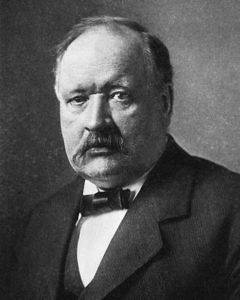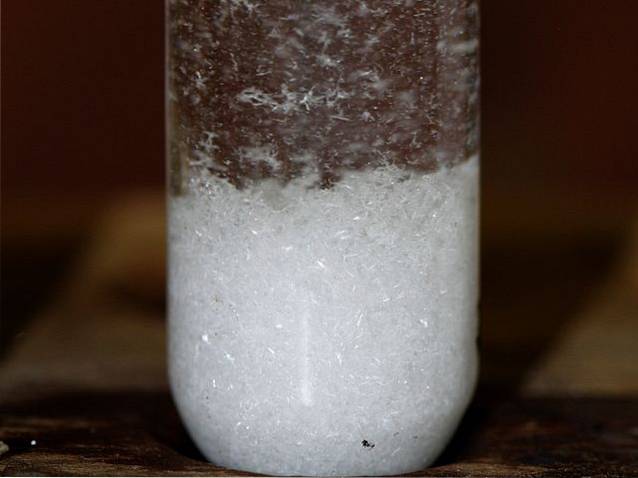
Svante August Arrhenius biography, theories, contributions, works

Svante August Arrhenius (1859-1927) was a Swedish physicist and chemist known worldwide for his work in the area of electrolytic dissociation and other theories that made him a world leader in scientific research.
He was the first Swede to receive the Nobel Prize in Chemistry, a writer of scientific texts and recognized as the father of physics-chemistry; He taught at the university and published hypotheses about the origin of life and the formation of stars and comets..

Experts say Arrhenius's experiments were ahead of their time. An example of this was his research on the causative agents of global warming of the planet and his recommendations to avoid this serious problem that currently affects life on Earth.
Article index
- 1 Biography
- 1.1 Childhood and studies
- 1.2 New experiences
- 2 Theories
- 2.1 Electrolytic Dissociation Theory
- 2.2 Arrhenius equation
- 2.3 Arrhenius and climate change
- 2.4 The origin of life and other contributions
- 3 Works
- 4 Acknowledgments
- 5 Personal life
- 6 References
Biography
Childhood and studies
Svante August Arrhenius was born on February 19, 1859 on a rustic farm located in Vik, Sweden. His father was Gustav Arrhenius and his mother Carolina Christina Thunberg.
From a very young age he was in contact with the academic world, since his uncle Johann Arrhenius was professor of botany and later rector of the School of Agriculture in Ultuna, while his father worked as a surveyor at the University of Uppsala.
In order to improve their economic situation, the family moved to Uppsala in 1860, just one year after the birth of little Svante, who proved to be a prodigy from a very young age. It is stated that by the age of three he was already reading on his own and solving simple mathematical operations.
Arrhenius studied at the Uppsala Cathedral School, a historically prestigious campus founded in 1246, from which he graduated in 1876 with excellent grades..
At the age of 17, he entered the University of Uppsala where he studied mathematics, physics and chemistry. Five years later he moved to Stockholm to work under Professor Erick Edlund (1819-1888) at the Royal Swedish Academy of Sciences..
Arrhenius was initially assisting Edlund with research, but soon began work on his own doctoral thesis. Investigations on the galvanic conductivity of electrolytes, which he presented in 1884 at the University of Uppsala.
This research revolved around the dissolution of electrolytes in aqueous solutions and their ability to generate positive and negative ions that conduct electricity. Unfortunately, the theory was classified as erroneous, so the research was approved with a minimum score and objected by their classmates and teachers.
New experiences
This rejection by the scientific community did not stop Arrhenius, who sent copies of his thesis to renowned scientists such as Rudolf Clausius (1822-1888) Julios Lothar Meyer (1830-1895) Wilhem Ostwald (1853-1932) and Jacobus Henricus van 't Hoff. (1852-1811).
Arrhenius continued to train and learn from his colleagues. He received a scholarship from the Academy of Sciences that allowed him to travel and work in laboratories of leading researchers in places like Riga, Graz, Amsterdam and Leipzig.
He began his activity as a teacher in 1891, teaching Physics classes at the University of Stockholm. Six years later, he was appointed rector of this higher education campus.
Theories
Electrolytic Dissociation Theory
During his time as a university professor, Arrhenius continued to work on the research on the aqueous solutions discussed in his doctoral thesis. This new review of his data and experiments served as the basis for presenting his Theory of Electrolytic Dissociation in 1889..
Arrhenius claimed that an electrolyte was any substance that, when dissolved in an aqueous solution, was capable of conducting an electric current.
After their dissolution, these electrolytes dissociated, generating a positive and a negative charge, which he called ions. The positive part of these ions was called cation and the negative anion.
He explained that the conductivity of a solution depends on the amount of concentrated ions in the aqueous solution..
The solutions in which these electrolytes were ionized were classified as acids or bases, depending on the type of negative or positive charge they formed..
These results made it possible to interpret the behavior of acids and bases that were known until then and gave an explanation to one of the most important properties of water: its ability to dissolve substances.
This research made him worthy of the Nobel Prize in Chemistry in 1903, which enshrined him among his national and foreign peers..
Two years after receiving this important award, he assumed the direction of the recently inaugurated Nobel Institute for Physical Chemistry, a position he held until his retirement in 1927.
Arrhenius equation
Arrhenius proposed in 1889 a mathematical formula to check the dependence between temperature and the speed of a chemical reaction.
A similar study had been initiated in 1884 by the scientist van't Hoff, but it was Arrhenius who added a physical justification and the interpretation of the equation, offering a more practical approach to this scientific contribution..
An example of this study can be observed in everyday life, when food is stored in a refrigerator, where low temperatures allow the chemical reaction that causes its deterioration to be slower and therefore it is suitable for consumption for a longer time.
The Arrhenius equation can be applied to homogeneous gaseous reactions, in solution and to heterogeneous processes.
Arrhenius and climate change
More than a hundred years ago, when global warming was not a matter of debate and concern, Arrhenius was already beginning to raise it by offering forecasts about the future of life on the planet..
In 1895 he devoted himself to studying the link between the concentration of carbon dioxide (COtwo) in the atmosphere and the formation of glaciers.
It concluded that a 50% reduction in (COtwo) could mean a 4 or 5 ° C drop in the planet's temperature, which could generate massive cooling, similar to that of the glacial periods through which the earth has passed.
On the other hand, if these CO levelstwo increased 50%, a reverse result would occur, a temperature rise of 4-5 ° C causing abnormal warming, with devastating consequences for the Earth's climate.
Arrhenius also determined that fossil fuels and the incessant industrial activity of the human being would be the main causes of this increase in the concentration of COtwo atmospheric.
His calculations predicted a proven effect on the natural balance of our planet, making Arrhenius the first man to carry out formal research on this topic..
The origin of life and other contributions
The subjects of his interest were very diverse. He offered contributions in the area of cosmology with a theory about the origin of comets that attributed the pressure of solar radiation to their formation; in addition to a theory about the evolution of the stars.
The study about the origin of life was not overlooked by this scientist, who in his Theory of Panspermia stated that the germ of life is scattered throughout the universe and that it only needs to have the necessary conditions to develop.
A very modern theory if one takes into account that scientists are currently studying the presence of interplanetary material in meteorites fallen on earth and the possibility that these have served as a vehicle for the first spark of life on the planet.
Arrhenius received during his life multiple job offers from other countries, however he always preferred to work in Sweden. The period in which he worked at the University of California, United States, and which left his book as a result, can be counted as an exception Immunochemistry (1907).
Plays
Arrhenius also excelled as a prolific writer, publishing scholarly works and speeches..
- Theoretical Electrochemistry (1900).
- Treatise on Cosmic Physics (1903).
- Theory of Chemistry, the Earth and the Universe (1906).
- Immunochemistry (1907).
- Worlds in Creation: The Evolution of the Universe (1908).
- Quantitative Laws in Biological Chemistry (1915).
- The Fate of the Stars (1915).
- Chemistry and Modern Life (1915).
- Theory of Solutions (1918).
Some texts were written exclusively for the in-depth analysis of the study and chemical practice, but he also made several publications of an easy-to-interpret narrative not only by the academic community but by the general public..
Acknowledgments
The most outstanding award that Arrhenius was awarded was undoubtedly the Nobel Prize in Chemistry that he received in 1903 thanks to his Theory on Electrolytic Dissociation, and which made him the first Swede to be worthy of such honor..
In 1902, the Royal Society of London awarded him the Davy medal and that same institution named him a Foreign Member in 1911.
That same year he was the first to receive the Willard Gibbs medal awarded by the American Chemical Society.
In 1914 he obtained the Faraday medal awarded by the Institute of Physics of the United Kingdom, in addition to a series of distinctions and honorary academic degrees offered by about ten distinguished European universities.
In his honor the lunar crater Arrhenius and the Arrhenius crater of Mars were also named.
Personal life
Historians claim that Arrhenius was of great human spirit. In fact, during World War I he strove to help free and repatriate scientists who had been made prisoners of war..
He married twice, in 1884 to Sofia Rudbeck, his student and assistant with whom he had a son. Twenty-one years after his first marriage, he married María Johansson, having three children..
He worked tirelessly until his death in Stockholm on October 2, 1927 at the age of 68..
References
- Bernardo Herradon. (2017). Arrhenius, one of the fathers of modern chemistry. Taken from principia.io
- Elisabeth Crawford. (2015). Svante Arrhenius, Swedish Chemist. Taken from Britannica.com
- Miguel Barral. (2019). Svante Arrhenius, The man who foresaw climate change. Taken from bbvaopenmind.com
- Miguel G. Corral (2011). Meteorites could detonate the beginning of life. Taken from elmundo.es
- Svante Arrhenius. Taken from newworldencyclopedia.org
- Francisco Armijo de Castro. (2012). One hundred years of mineral-medicinal waters. Two Hydrologists: Antoine Lavoisier and Svante Arrhenius. Taken from magazines.ucm.es



Yet No Comments